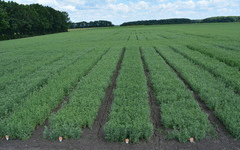Variety test of winter wheat in rice crop rotations
DOI:
https://doi.org/10.21498/2518-1017.2.2005.67461Keywords:
озима пшениця, сорт, врожайність, адаптивність, випробування, зрошення, рисова сівозмінаAbstract
Questions of winter wheat cultivation in rice crop rotations, which further to make the most efficient use of soil, increase of fertility and receive an additional yield per unit of crop area are studied in the article. The results of ecological variety test of winter wheat in rice check conditions have represented. The varieties with the best adaptive properties, yield and high qualitative indices of grain are park out. The conclusions about expediency of burther study improvements guestions of winter wheat ecological variety test are made with the purpose of selection varieties the most adapted to specific rice checks contions.Downloads
References
Ванцовский А.А., Вожегов С.Г., Вожегова Р.А. та інші. Технологія вирощування рису з врахуванням вимог охорони навколишнього середовища в господарствах України. - Херсон, 2004. - 77 с.
Ванцовский А.А. Культура риса на Украине. - Херсон, 2004.- 164 с.
Методика Державного сортовипробування сільськогосподарських культур. - К. 2000.
Методические указания по экологическому сортоиспытанию зерновых культур. - М. 1980.
Доспехов Б.А. Методика полевого опыта. - М. 1985.
Методические рекомендации проведения комплексных исследований по созданию зональных моделей блока защиты растений в экологически опасных зерновых комплексах. - Л., 1990.- 34 с.
Downloads
Published
How to Cite
Issue
Section
License
Copyright (c) 2005 Ukrainian Institute for Plant Variety Examination

This work is licensed under a Creative Commons Attribution-ShareAlike 4.0 International License.
Starting in 2022, the copyright to the publication remains with the authors
Our journal abides by the CREATIVE COMMONS copyright rights and permissions for open access journals.
Authors, who are published in this journal, agree to the following conditions:
- The authors reserve the right to authorship of the work and pass the first publication right of this work to the journal under the terms of a Creative Commons Attribution License, which allows others to freely distribute the published research with the obligatory reference to the authors of the original work and the first publication of the work in this journal.
- The authors have the right to conclude separate supplement agreements that relate to non-exclusive work distribution in the form in which it has been published by the journal (for example, to upload the work to the online storage of the journal or publish it as part of a monograph), provided that the reference to the first publication of the work in this journal is included.

























 Ukrainian Institute for Plant Varieties Examination
Ukrainian Institute for Plant Varieties Examination  Селекційно-генетичний інститут
Селекційно-генетичний інститут Institute of Plant Physiology and Genetics of the National Academy of Sciences of Ukraine
Institute of Plant Physiology and Genetics of the National Academy of Sciences of Ukraine
 The National Academy of Agrarian Sciences of Ukraine
The National Academy of Agrarian Sciences of Ukraine